From Small Town Tailor to Global Sportswear & Fashion Brand: The ellesse Story
Sponsored Story
ellesse founder Leonardo Servadio started out as a tailor in his hometown Perugia, Italy.
Like many great ideas, ellesse — which gets its name from Servadio’s initials L.S. —
was a way for its founder to scratch his own itch. Born into a family of textile merchants,
Servadio dreamt of fashion-forward sportswear that suited his stylish, tailored aesthetic.
With nothing satisfying available, Servadio decided to apply his knowledge to redefining
sportswear and, with that, ellesse was born in 1959.
ellesse: Then & Now
In the beginning, ellesse made apparel for two quintessentially Italian sports:
skiing and tennis. Servadio’s tailored approach led to iconic designs like the Jet Pant
which was included at a celebration of Italian design at the Pompidou Centre in 1979.
Fast forward 60 years, however, and while tennis and ski live on in ellesse’s designs
and logo, the label is as much a fashion brand as it is a sporting one. Here’s a look
back at some of ellesse’s most memorable designs and how they continue to influence
today’s collections.
Click the images below to explore ellesse through the ages.
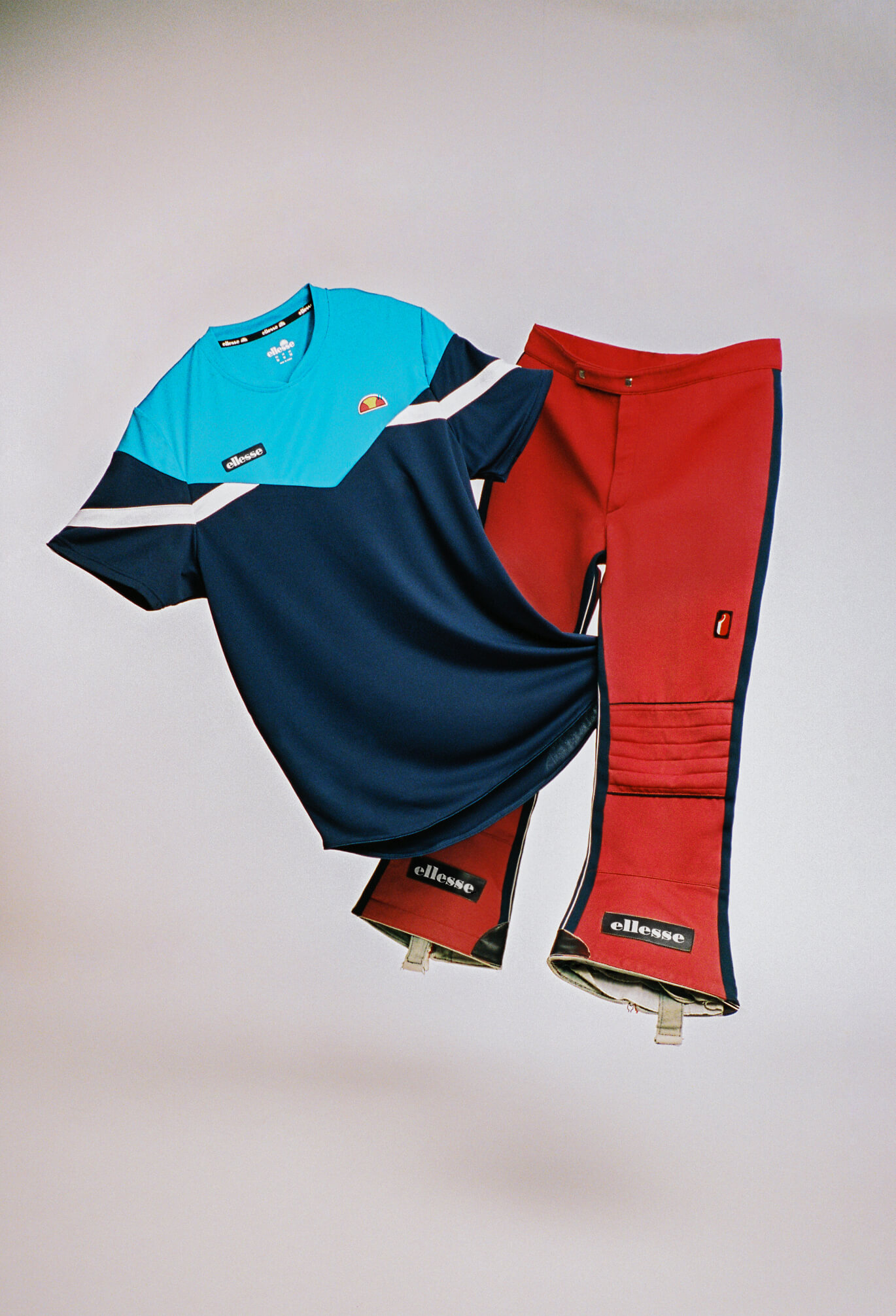
SS19 Aladino Tennis T-Shirt: Tee worn by British tennis player Cameron Norrie. Chevron pattern, color blocking, & dual branding reference ellesse heritage.
Original Jet Stripe Pants (1960s): The first ski pants to be worn outside the boot.

SS19 Sortoni Reflective Jacket: Reflective with dual branding.
Ski Jacket: Quilted with an embroider-applied logo inspired by founder Leonardo Servadio’s tailoring background.
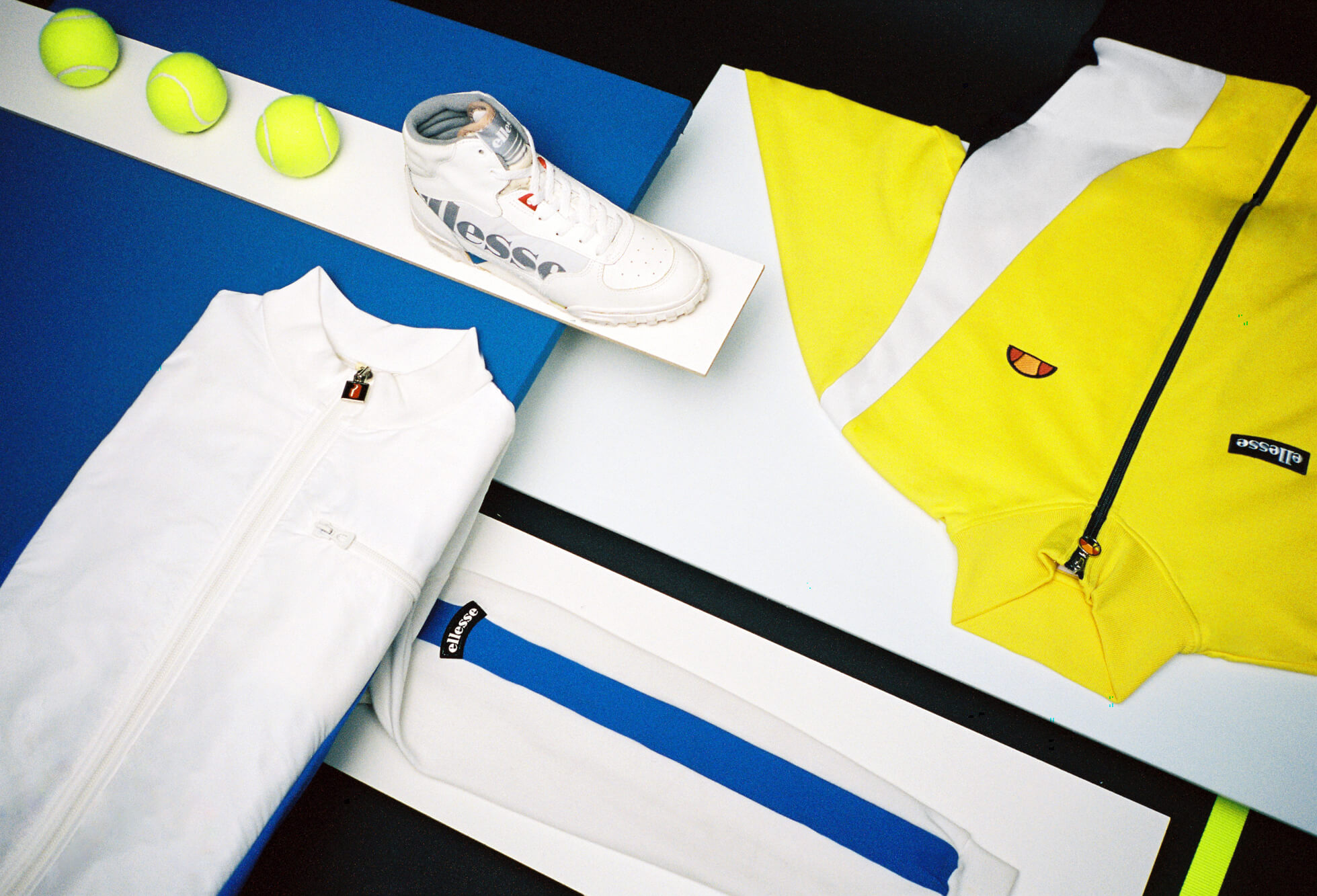
Original Tanker Sneaker (1980s): An original 80s court shoe with oversized branding on the upper.
Original Tennis Jacket (1980s): A white jacket with the original penguin logo on the zip.
SS19 Vilas Jacket: A replica of the yellow jacket worn by legendary Argentinian tennis star Guillermo Vilas.
Vilas’ name features on the back of the neck.
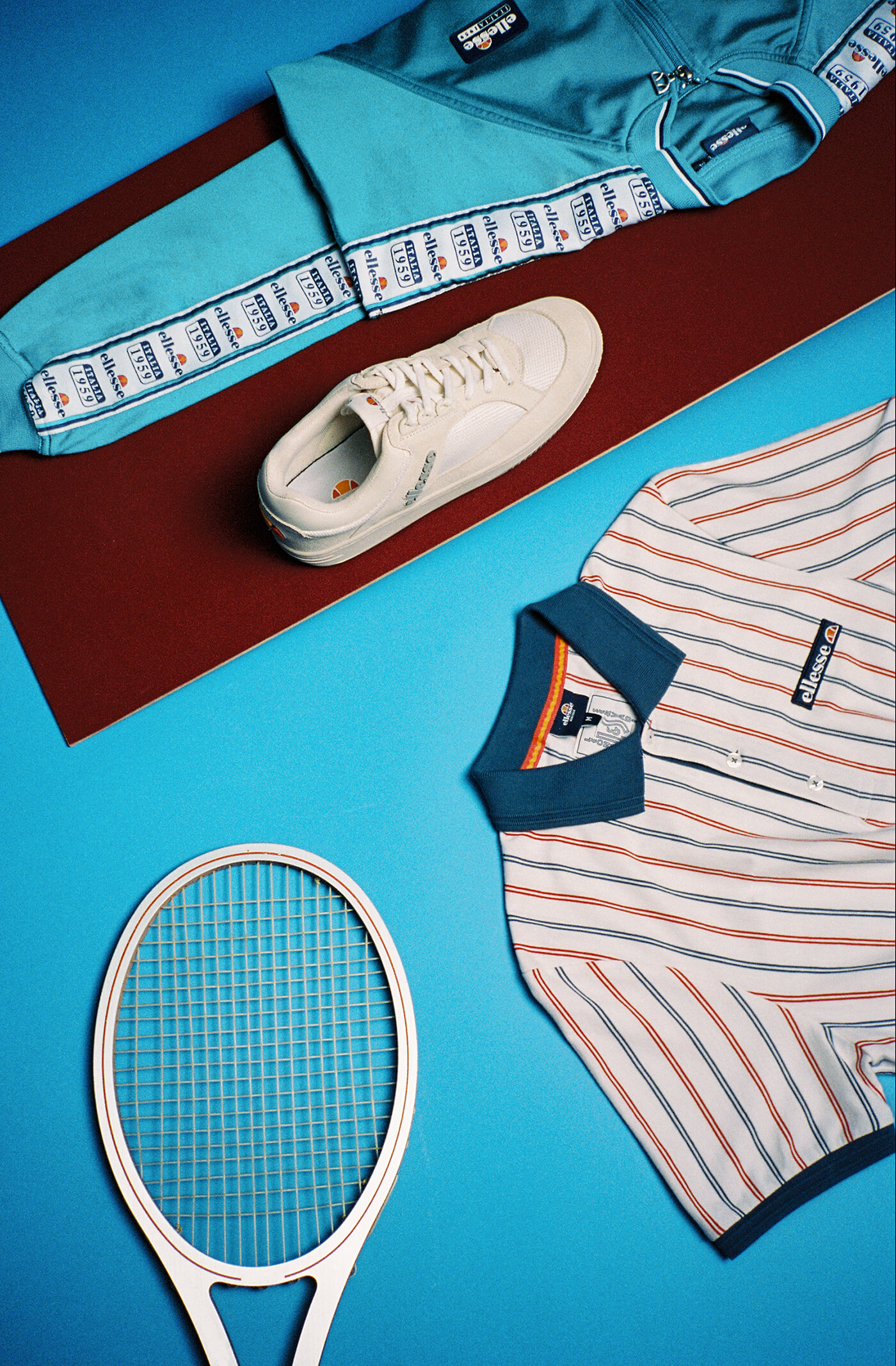
Original Tracktop (1990s): A 90s piece with signature ellesse sleeve taping.
SS19 Vinitziana 2.0 Sneaker (SS19): An 80s court shoe replica.
Original Tennis Polo (1980s): Tailoring-inspired design with embroidered badging and pinstripes.
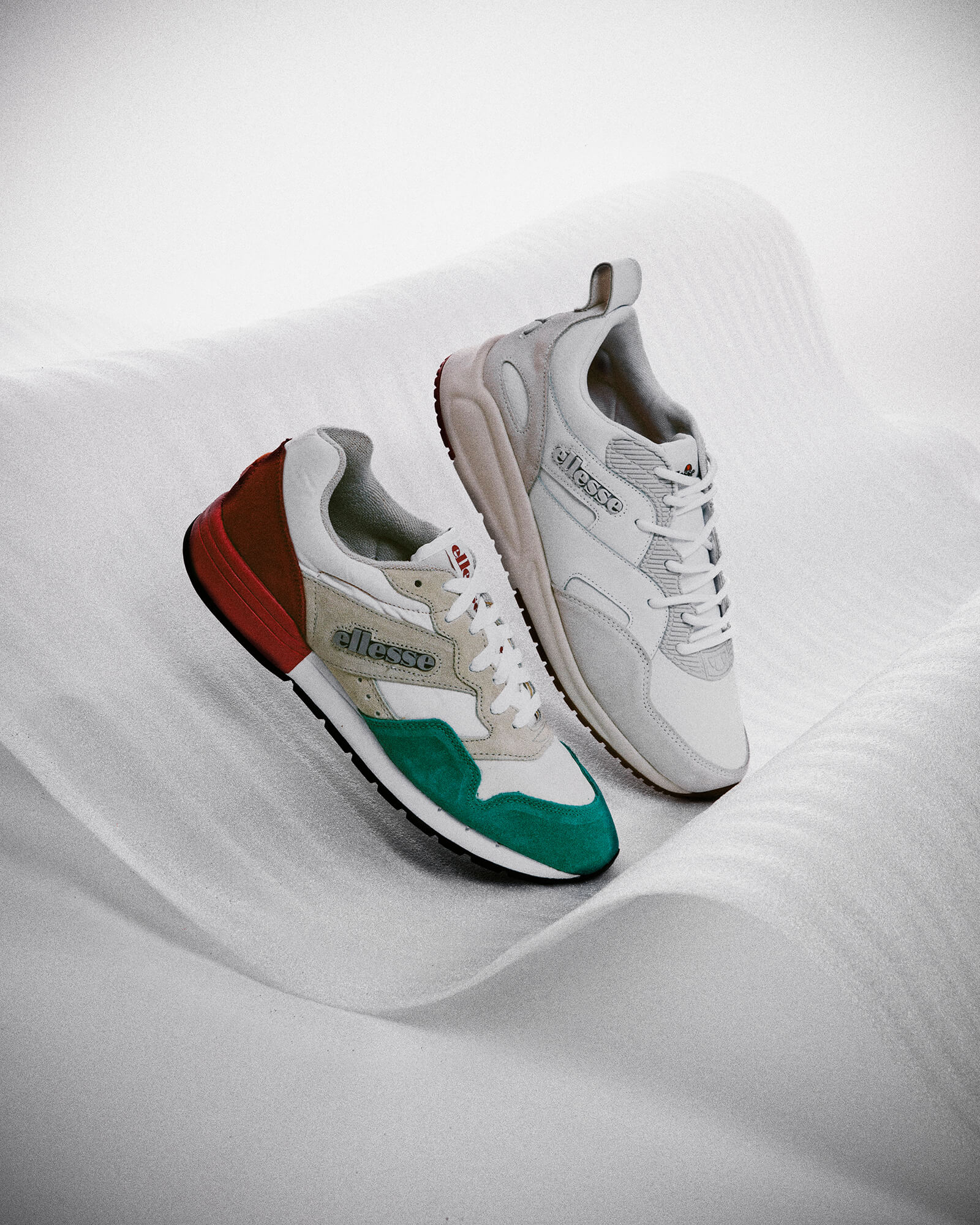
Original Marathon Shoe (1980s, green and red shoe): A running shoe featuring the Italian flag colors.
Potenza (SS19, white shoe): Inspired by 80s running silhouettes with original rubberized logos.
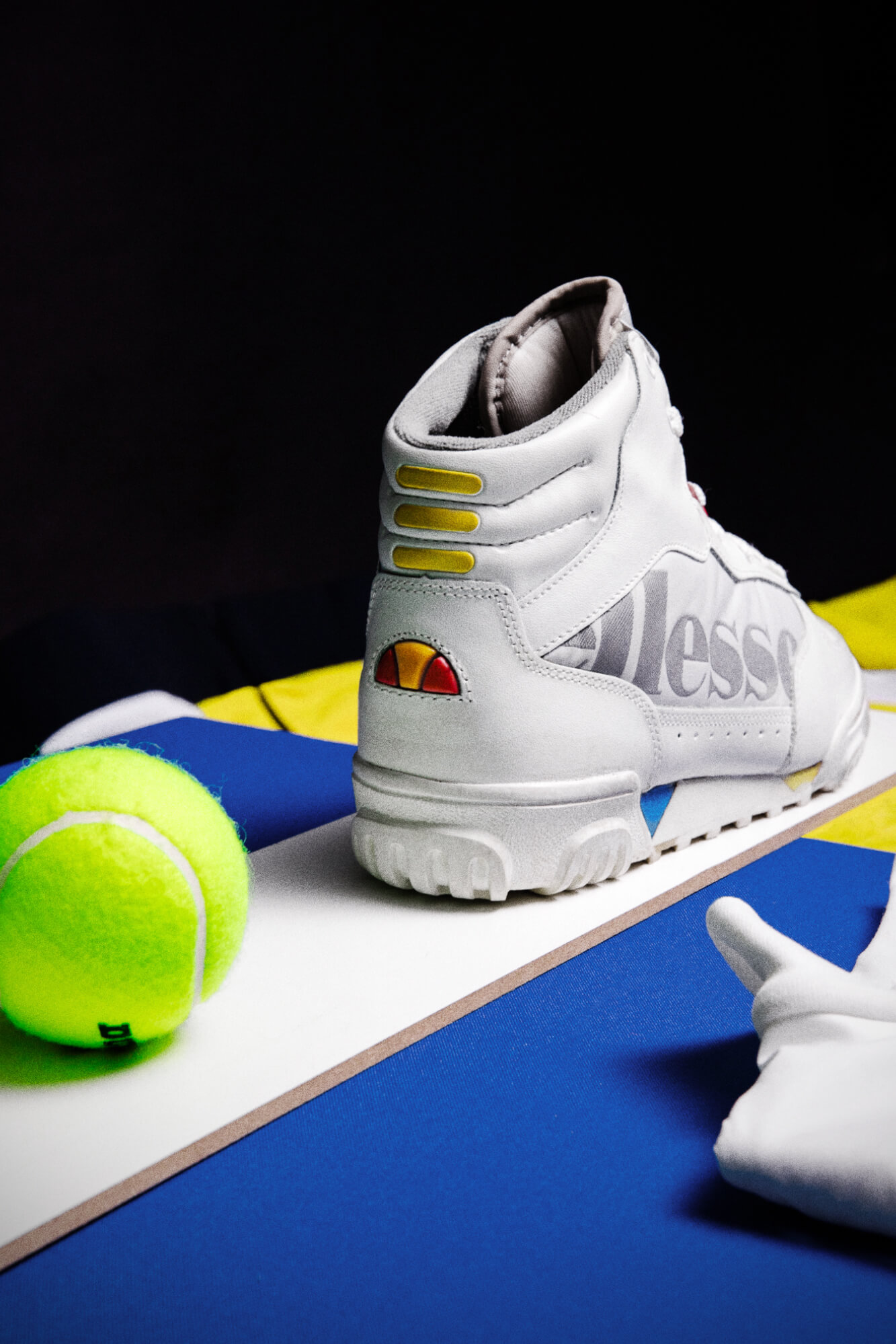
Original Tanker Sneaker (1980s): An original 80s court shoe with oversized branding on the upper.
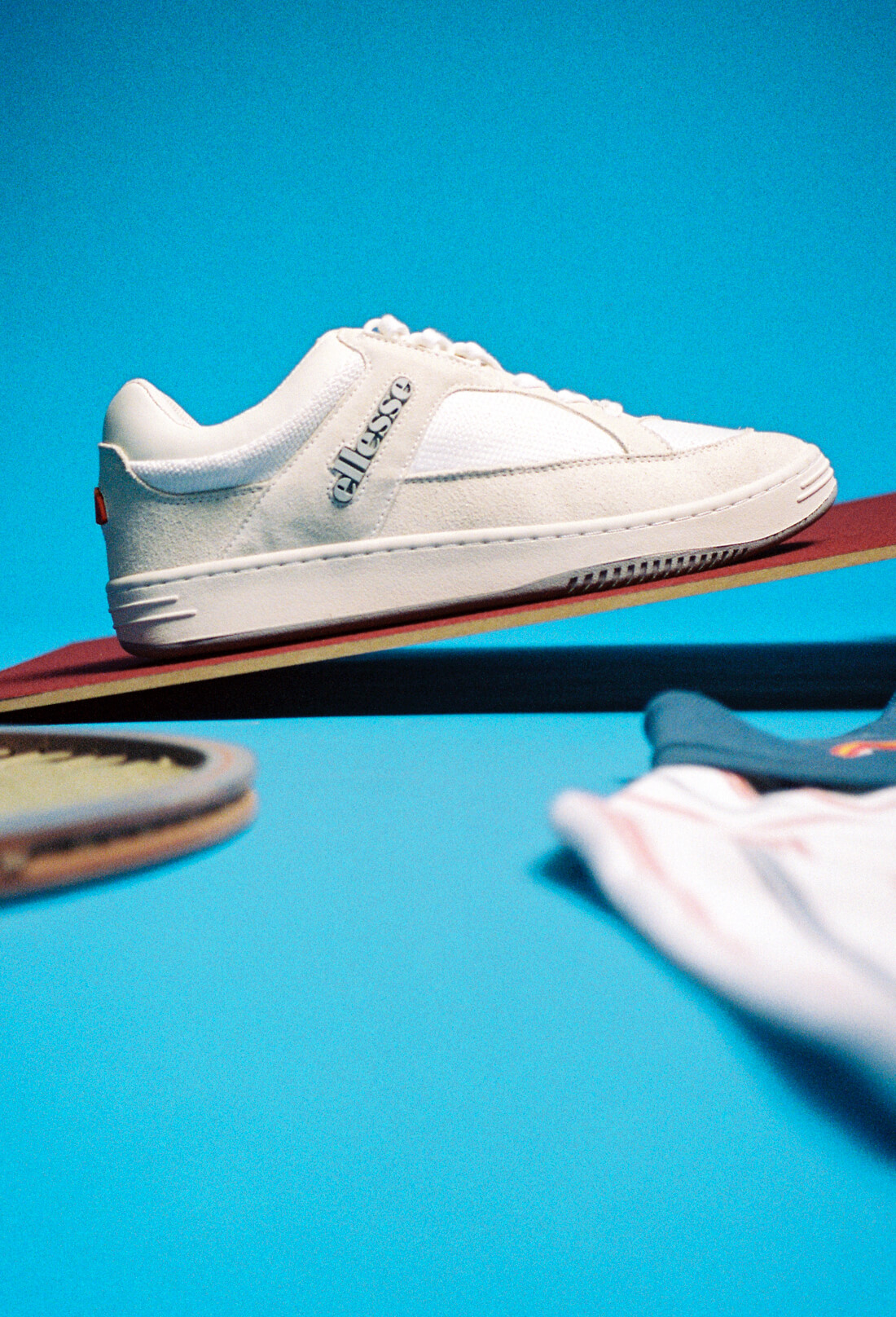
Vinitziana 2.0 Original Court Shoe (1980s): A replica of the original 80s ellesse court shoe.
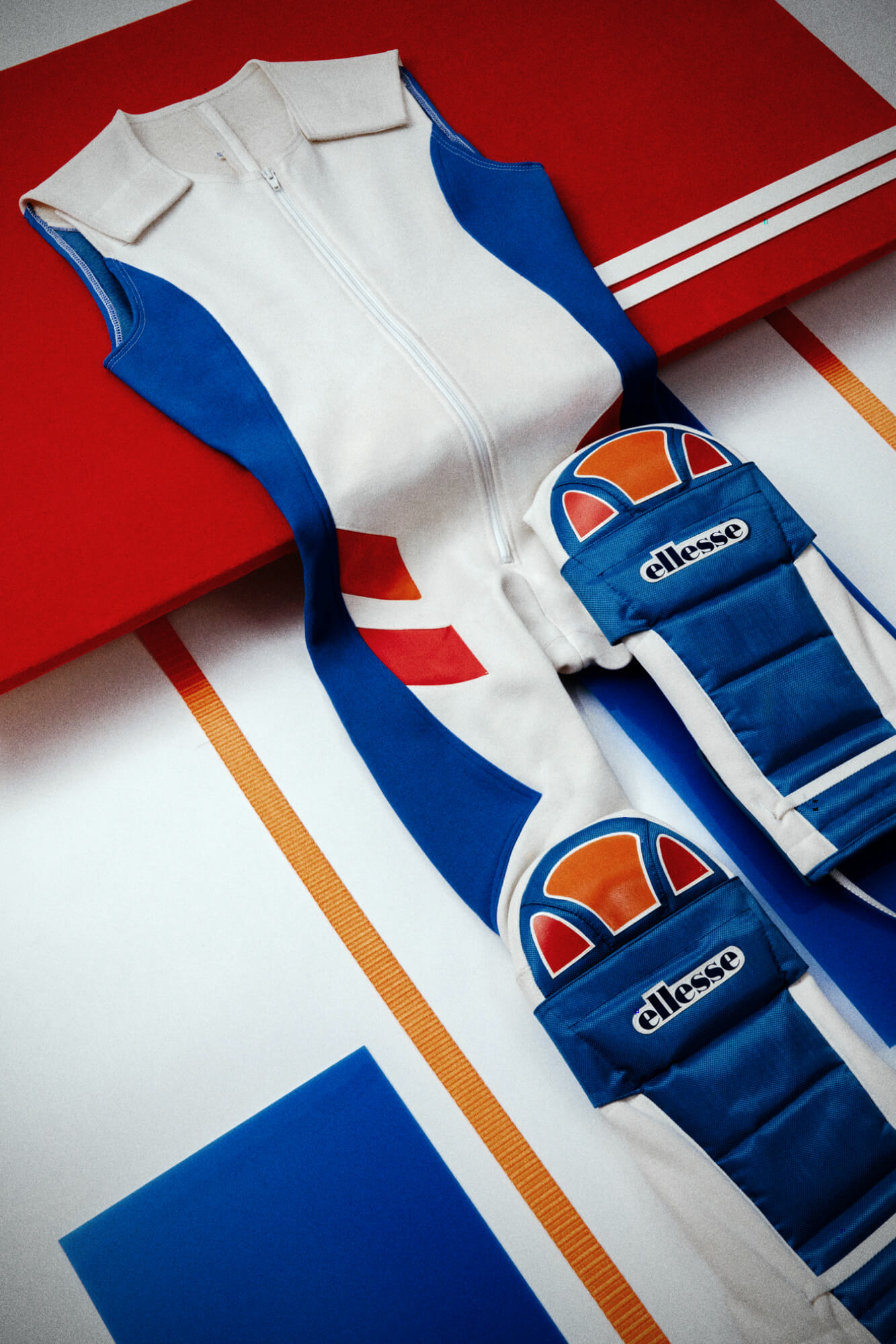
Downhill Racing Ski Suit (1980s): Featuring protective padded knee guards adorned with the
semi palla logo and color panels that tailor to the wearer’s form.
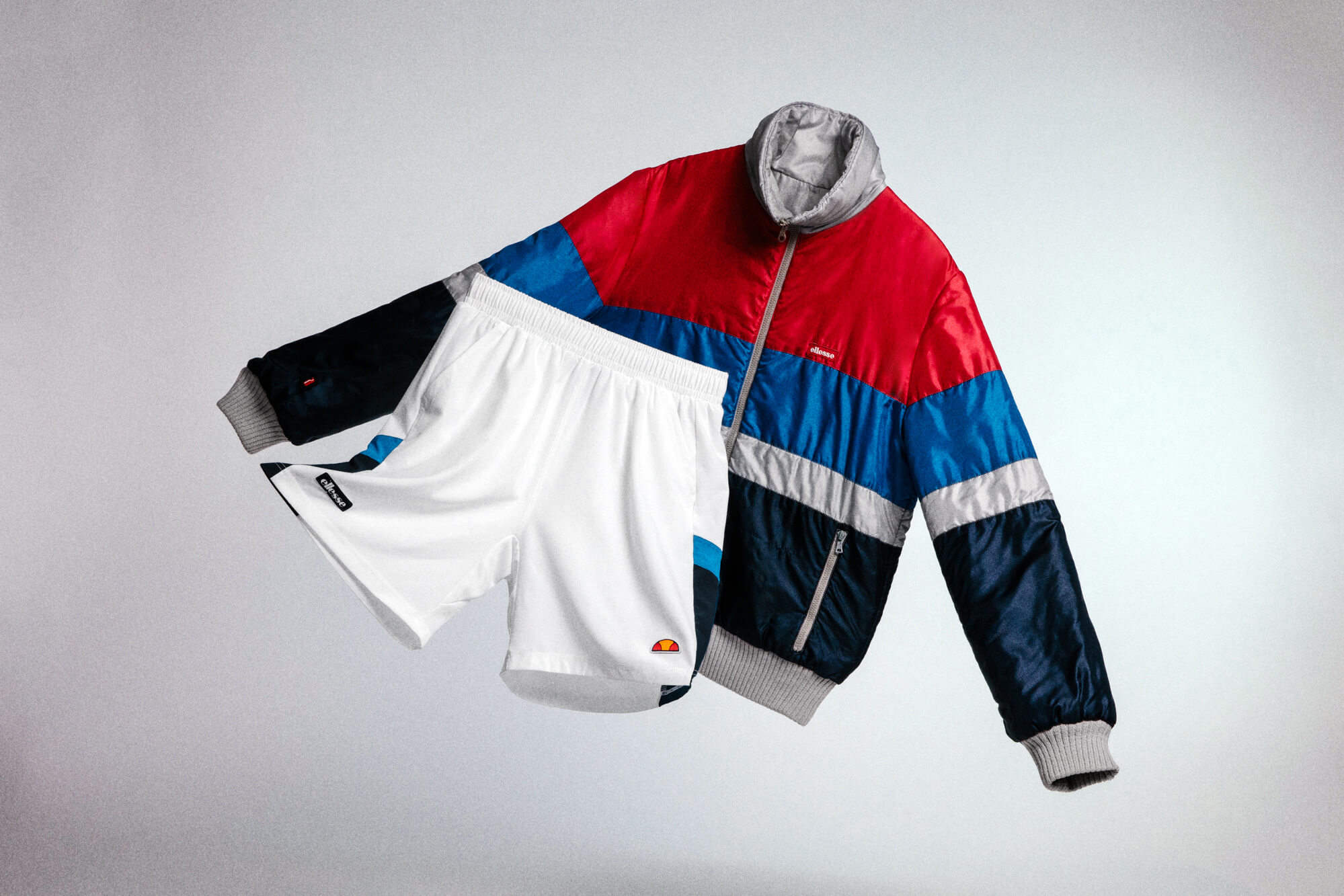
Ski Jacket (1970s): ellesse ignored convention with a fashion-forward, oversized, and less streamlined fit.
SS19 Tennis Shorts Cafone: A nod to the color blocking used on ellesse’s original skiwear.

SS19 Appop Popper Pants (left): Popper pants with classic ellesse taping.
The Jet Pants (middle): Original jetpants with quilted knees and jet stripes.
SS19 Orvati Track Pant (right): Shell pants reminiscent of ellese’s iconic 80s tracksuits.
A meeting of styles
ellesse was a pioneer in bringing tailoring techniques to the design and manufacturing of sportswear.
Yet, six decades on, these two styles of apparel still appear antithetical to some. In this video interview,
stylist and artist Ayishat Akanbi breaks down the stylistic, technical, and cultural crossover between
tailoring and sportswear.
“The ways that we wear sportswear and tailoring have changed dramatically, principally in that you can wear them seamlessly together.
No longer are you restricted to having to stick to tailoring or to stick to sportswear.”
– Ayishat Akanbi
ellesse in 2019
Today, ellesse is known for being a fashion brand as much as it is for being a sports brand.
In recent collections, its tailoring and sportswear heritage seamlessly converge with contemporary fashion trends and ellesse’s
recognizable color palette and semi-palla logo are ever-present symbols of the brand’s identity and history.
Yet, now, sportswear is having a similar impact on tailoring as tailoring had on sportswear under ellesse and Servadio’s influence.
Today’s tailored garments take as much from streetwear and sportswear as they do Italian traditions and people are subverting the
association of suiting with drudgery.
Honoring ellesse’s past, here’s how we shot and styled ellesse’s current offering.

Model is wearing the Alberta tee
and the Giglio sandal.
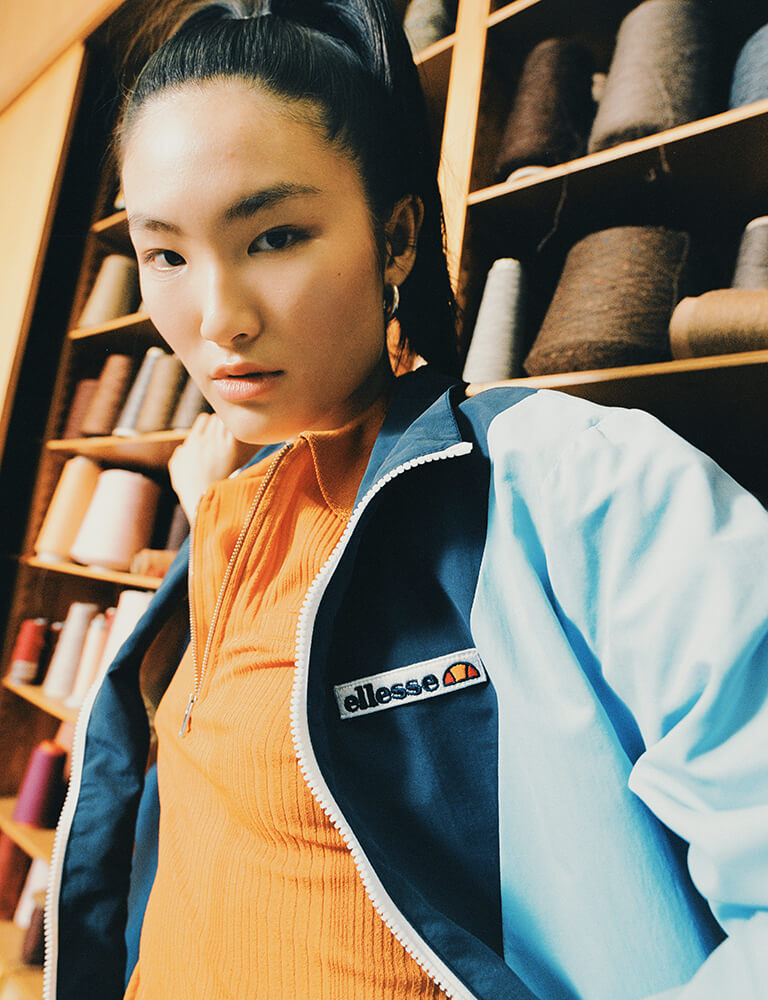
Model is wearing the Consolata jacket.
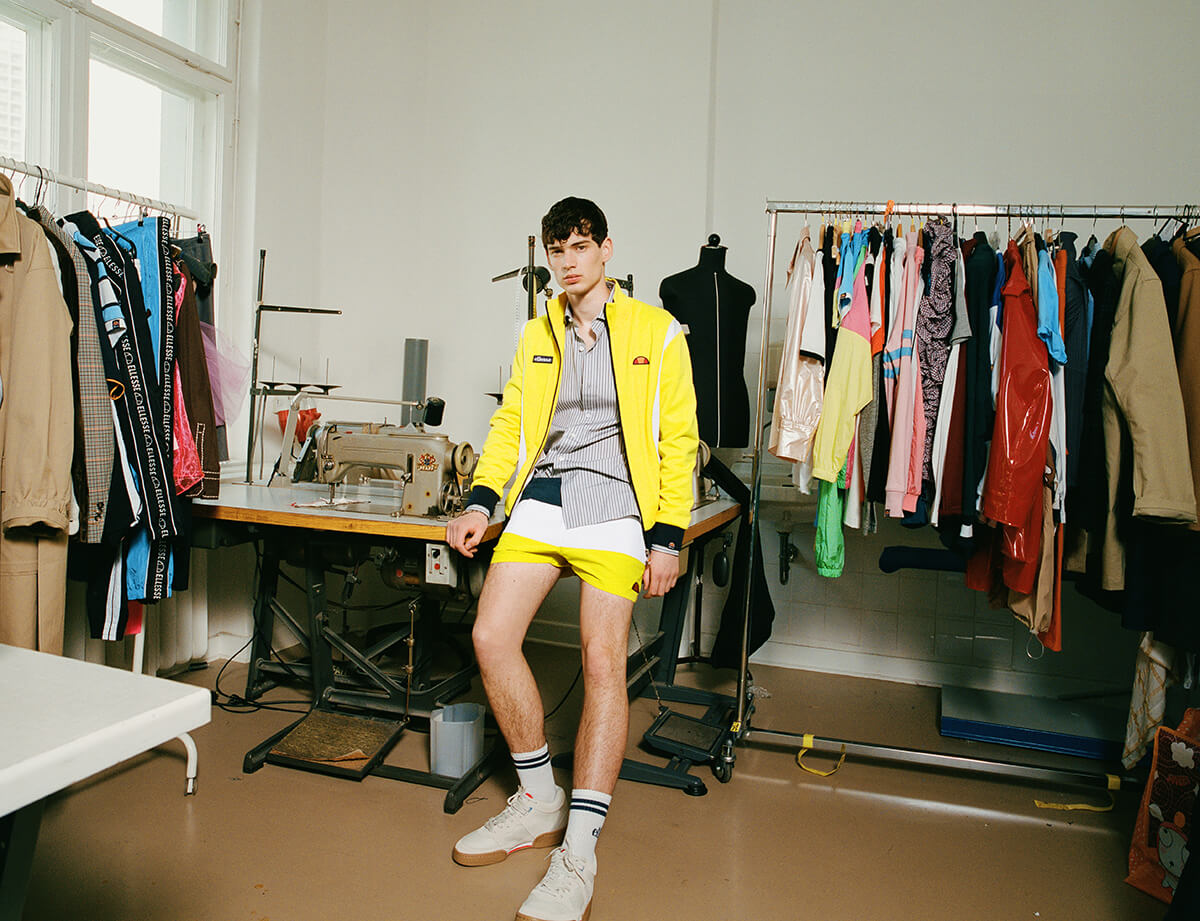
Model is wearing the Vilas Track jacket
and the Cielo shorts.
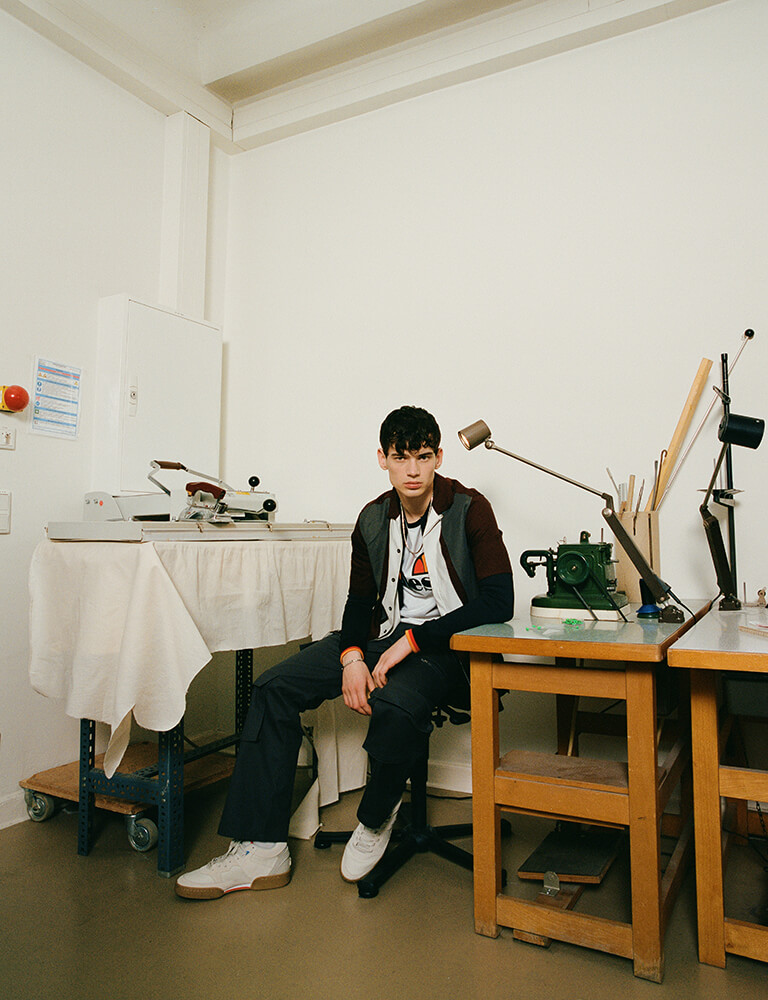
Model is wearing the Piazza trainer
and the Cassina tee.
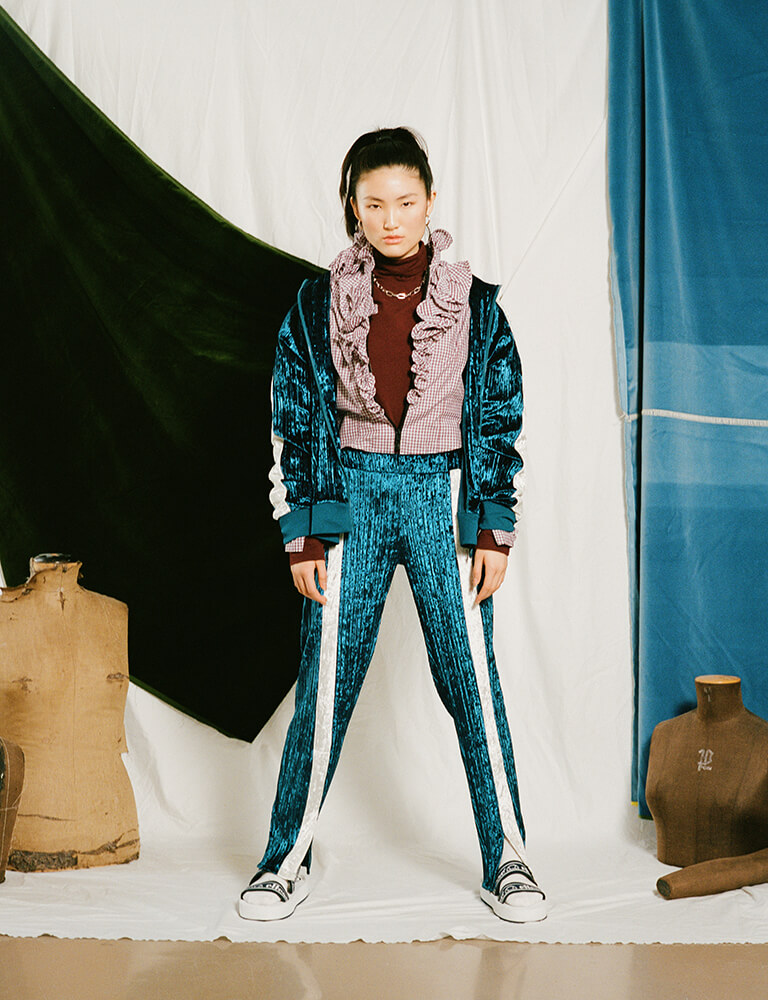
Model is wearing the Angelica tracktop and Veronica trackpants.
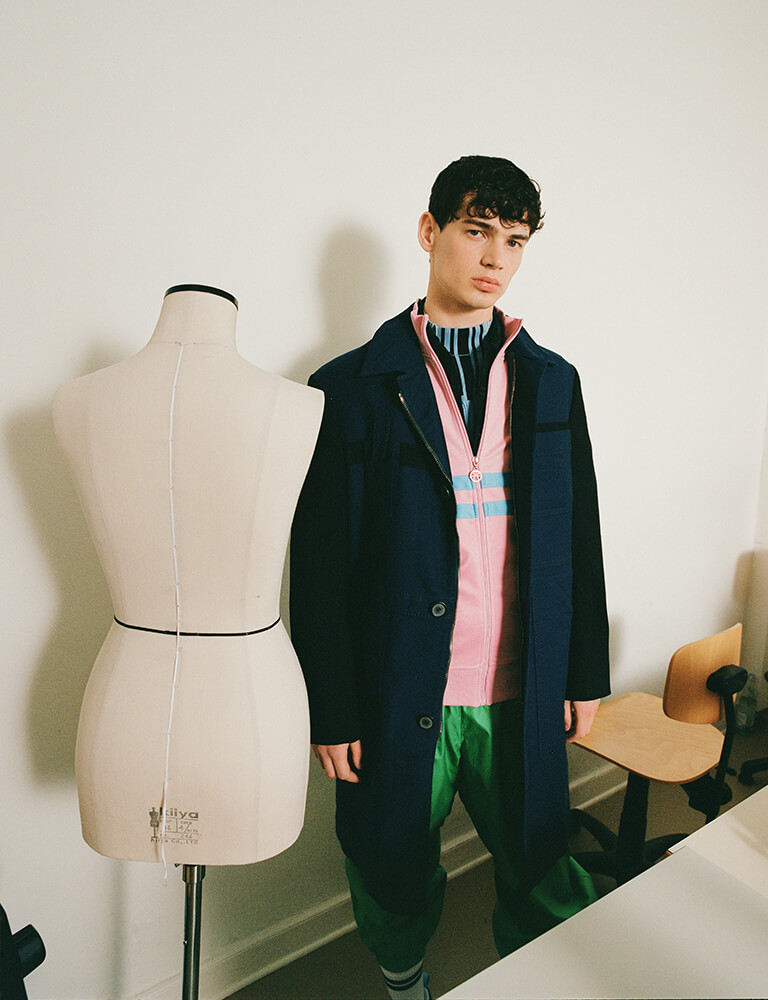
Model is wearing the Rimini tracktop.
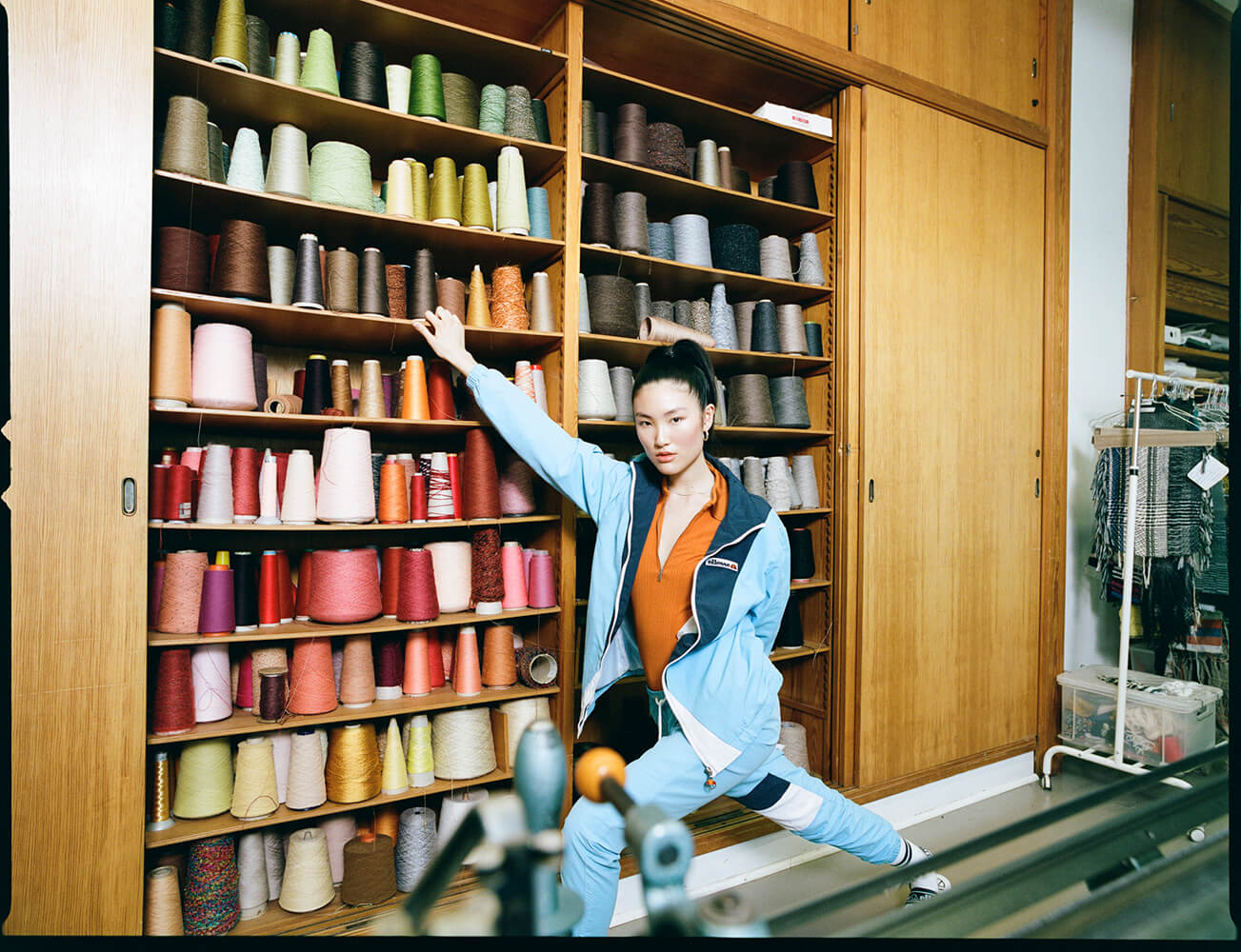
Model is wearing the Consolata jacket.
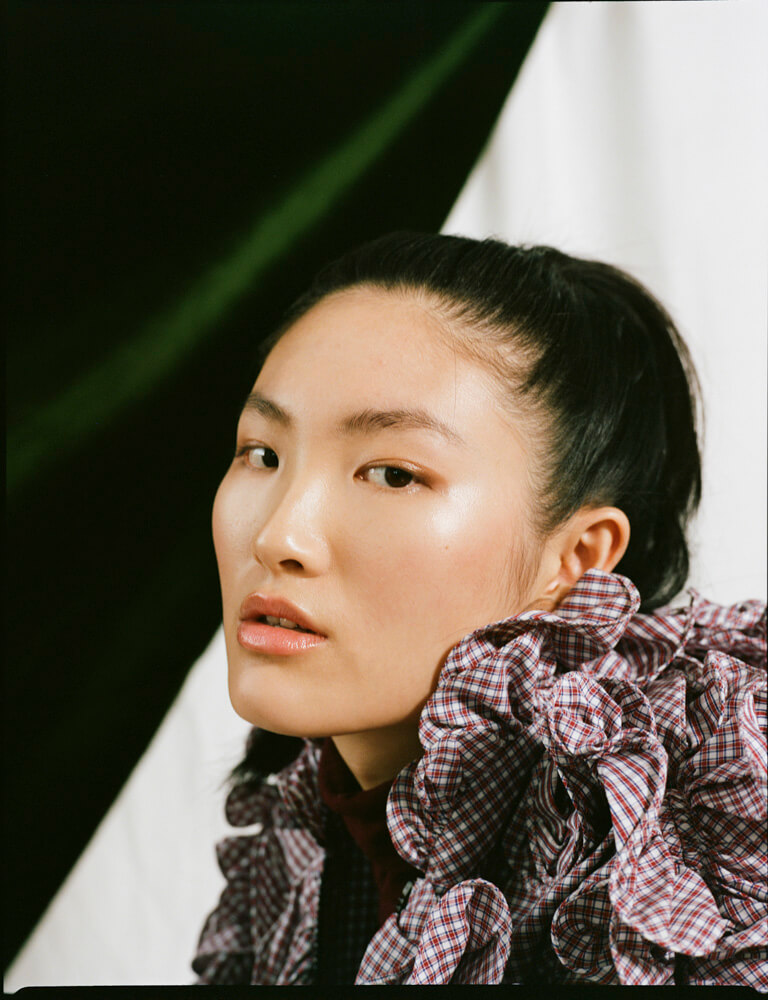
Model is wearing own jacket.

Model is wearing the Alberta tee.
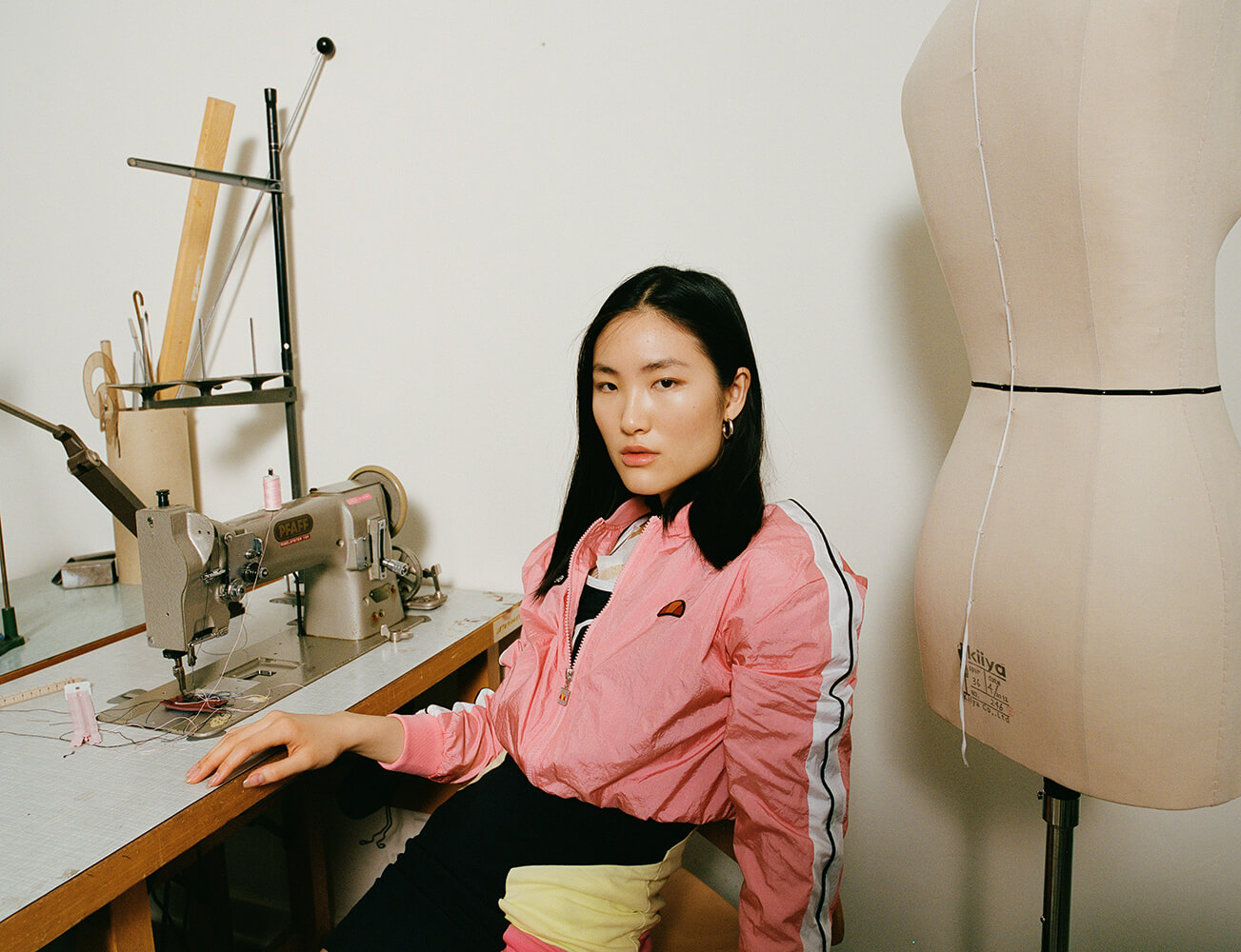
Model is wearing the Infanta dress and Spitfire jacket.
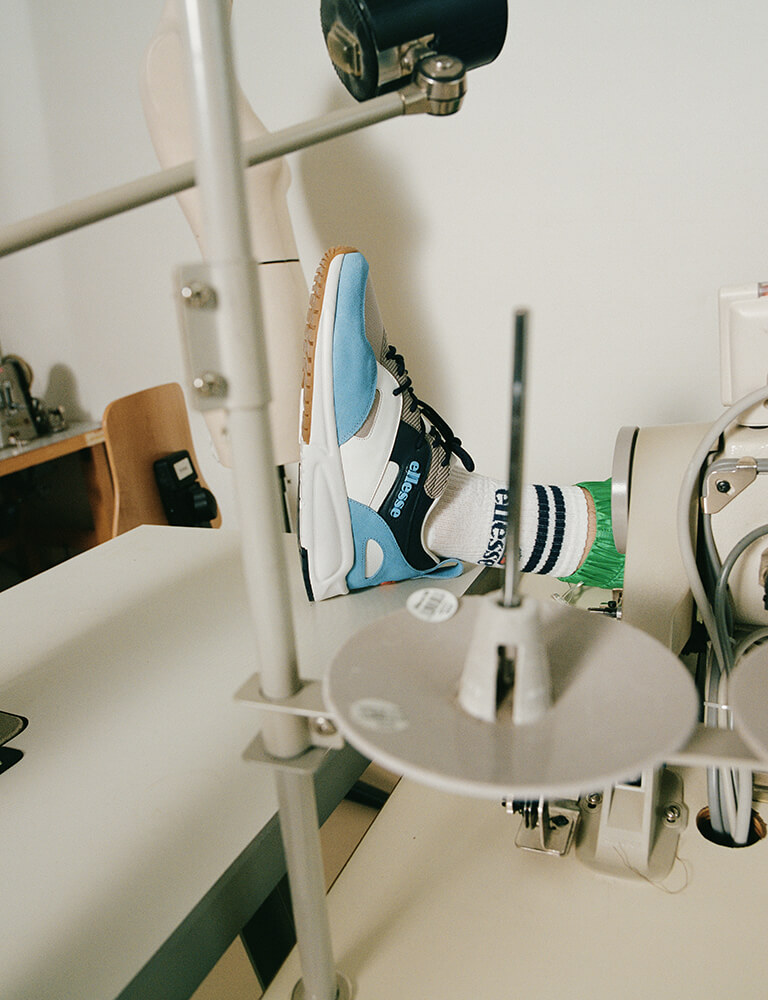
Model is wearing the Potenza trainers
and the Selina socks.
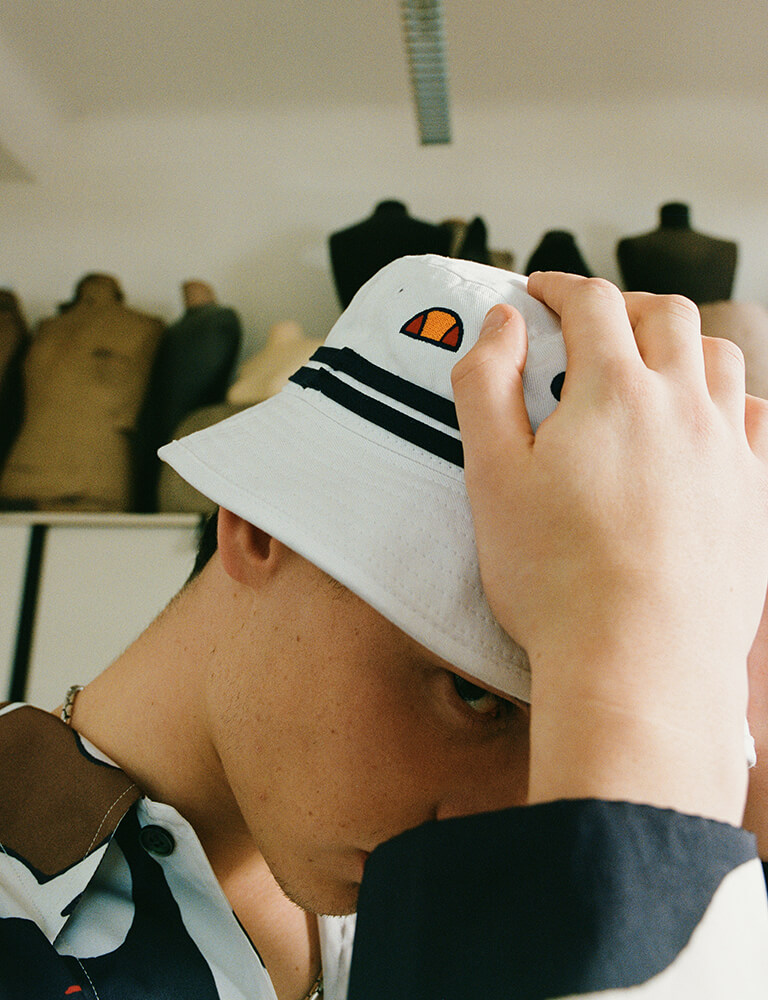
Model is wearing the Lorenzo bucket hat.
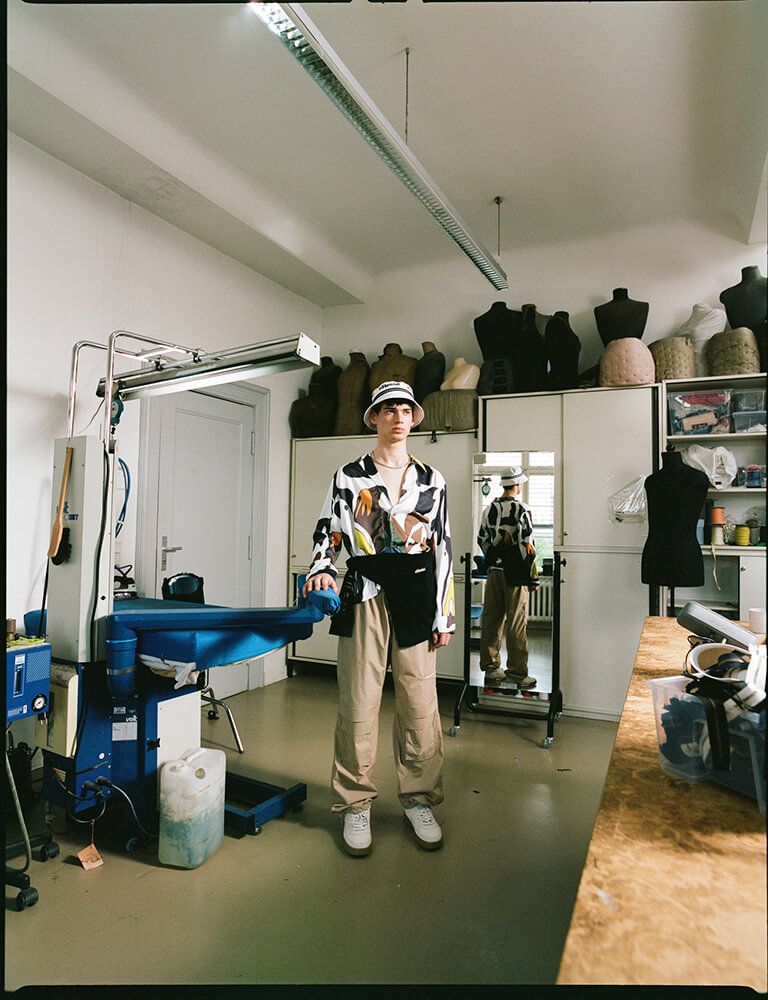
Model is wearing the Lorenzo bucket hat and Piazza trainer.
A Conversation With ellesse Collaborator Liam Hodges
ellesse has teamed up with rapidly rising British fashion designer Liam Hodges on an archive-inspired
Fall/Winter 2019 collection. To find out more, we visited Hodges for a conversation at his East London studio to
discuss ellesse’s rich history and how it’s inspired their partnership.
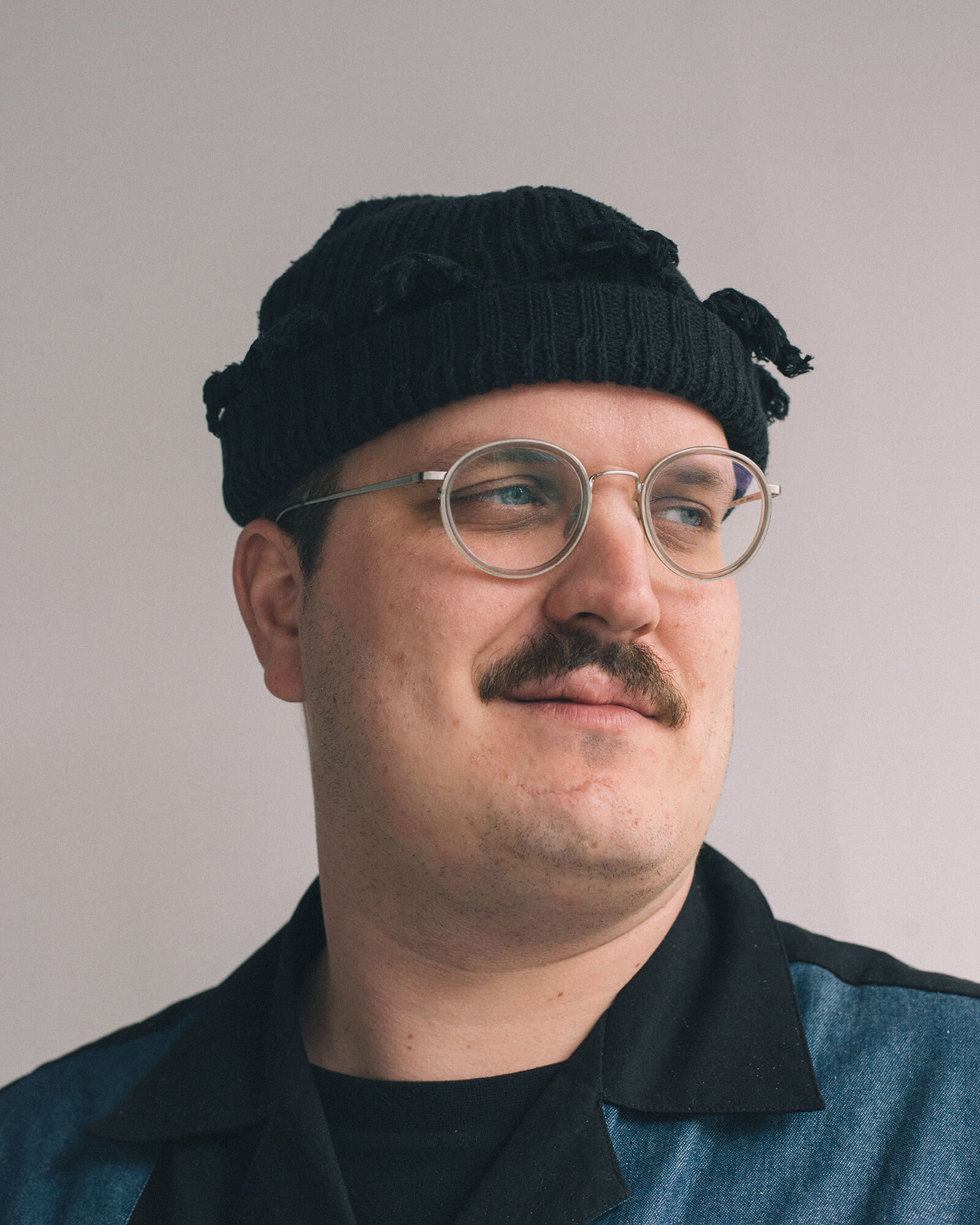
It’s been said before but it can’t be understated: Liam Hodges is not a conventional fashion designer.
Always plain-spoken and never pretentious, he’s frank from the minute we meet, “I was really hungover this morning.
We’ve just been dicking around today really.” After spending the previous evening in a London pub — a somewhat second
home for Hodges having worked in one up until just a couple of years ago — it had been a somewhat slow start to the day.
Now the afternoon, we were meeting to discuss his new collaboration with ellesse that was first teased back in January
during his London Fashion Week Men’s Fall/Winter 2019 show.
“I think, nowadays, there’s much more value in relevance and knowledge.”
– Liam Hodges
Hodges and his team work from a studio space in Newham, East London, and despite a penchant for mischief and play,
together they’ve helped grow the Liam Hodges brand exponentially over the last five years. Still in its youth,
the brand evolves each season, but every collection aims to redefine the meaning of aspirational with positive,
forward-looking statements inspired by Hodges’ ceaseless curiosity towards music, film, and books. “There’s this
old, archaic version of aspirational, the early 2000s version of cars and money and stuff like that,” he explains.
“And I think, nowadays, there’s much more value in relevance and knowledge.” The Liam Hodges mission statement has
led its namesake designer to turn some aspects of running a fashion business on their head. In the past, Hodges
has created zines rather than putting out traditional advertising and partnered with avante-garde music artists
such as GAIKA to soundtrack his shows. In doing so, he’s attracted the attention of Drake and Stormzy, amongst
others, but in truth, Hodges admits to just designing clothes that his mates would wear.
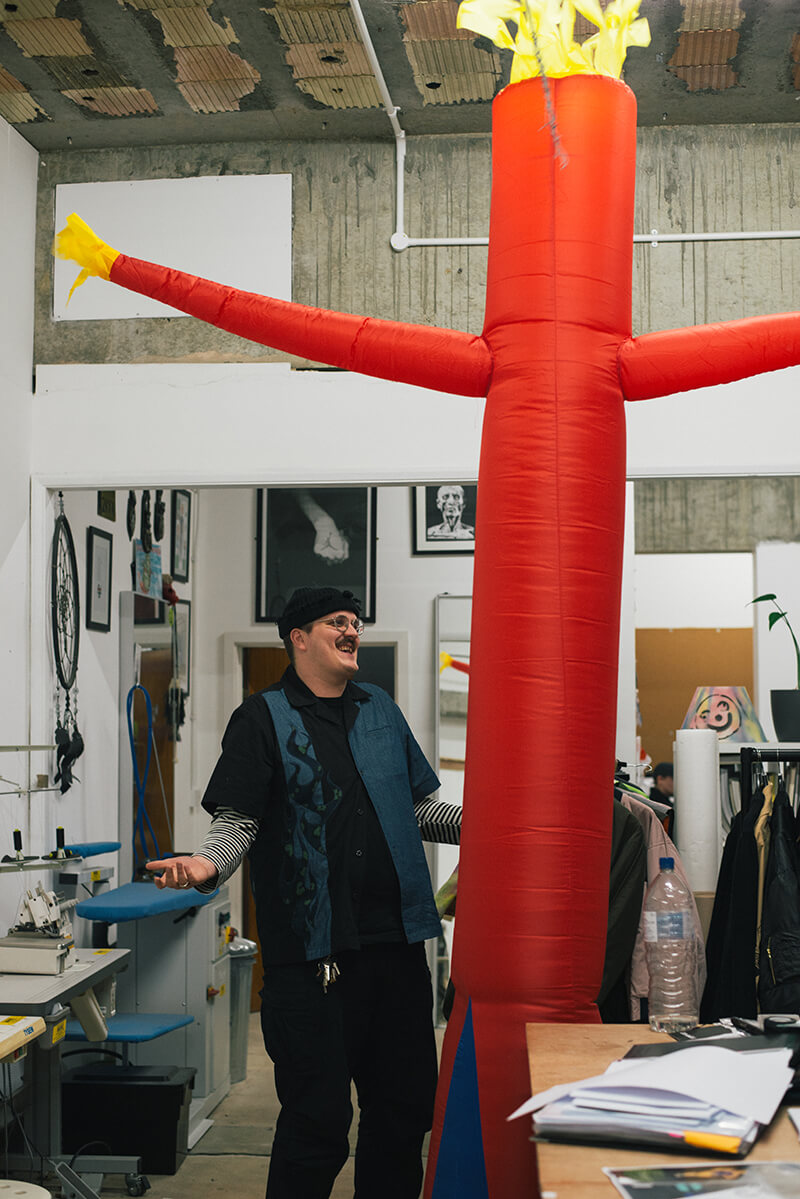

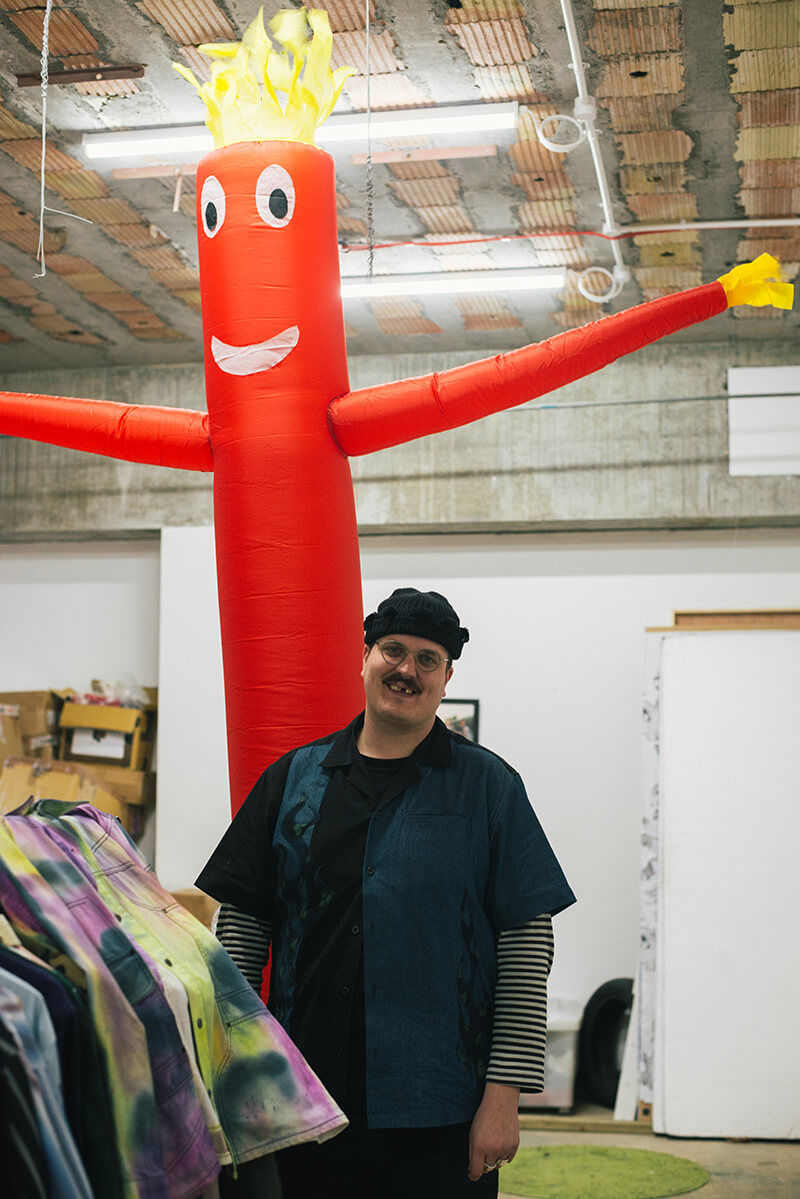
Hodges’ mental library touches upon everything from popular culture to more esoteric topics. It is, in part, the
reason his work is so diverse and his appeal so cross-cultural. In 2016 he described an obsession with Adam Curtis’
HyperNormalisation; his SS19 collection was directly influenced by his reading of Donna Tartt’s 2013 novel The Goldfinch;
today, on his desk, I spot a copy of Yuval Noah Harari’s 21 Lessons for the 21st Century. Case in point: Hodges is a
sponge for knowledge.
“That’s kind of where inspiration comes from, isn’t it, it’s from books and museums and stuff.
It’s not like I just go ‘ding’, and have it all right there. When I was doing the last collection I got really into a book
called Alone Together which is a study of how technology has changed people, changed how we communicate, and what we think
we are. Then there’s The Shallows which looks at how technology has changed the way our brains work, not needing to remember
things in the same way anymore, for example. But I guess that’s just what excites me, books, and comics books. And music.
I’m going to see Tommy Cash on Friday and I’ve been listening to Ho99o9 a lot recently when cycling to work, it helps me
get there faster.”
“I’d never seen a brand’s archive before, the way the clothes were designed, drawn, presented, and even sold was very interesting.”
– Liam Hodges
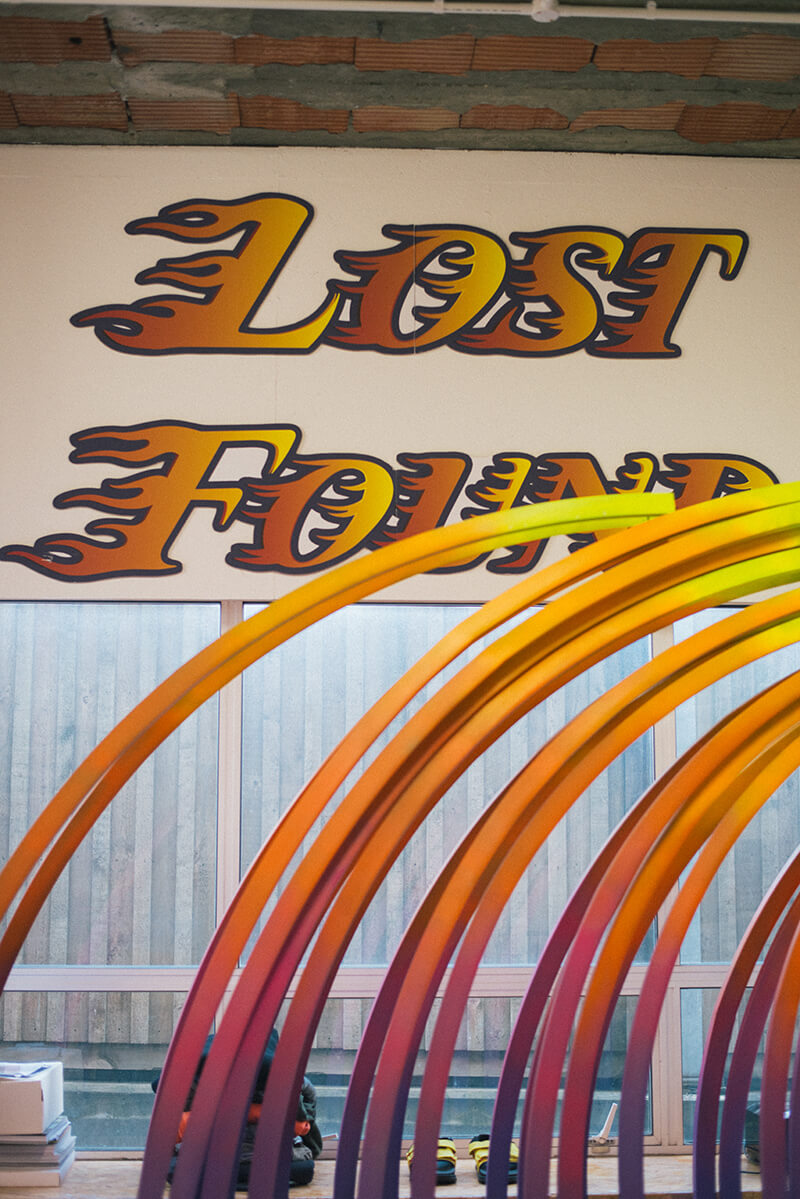
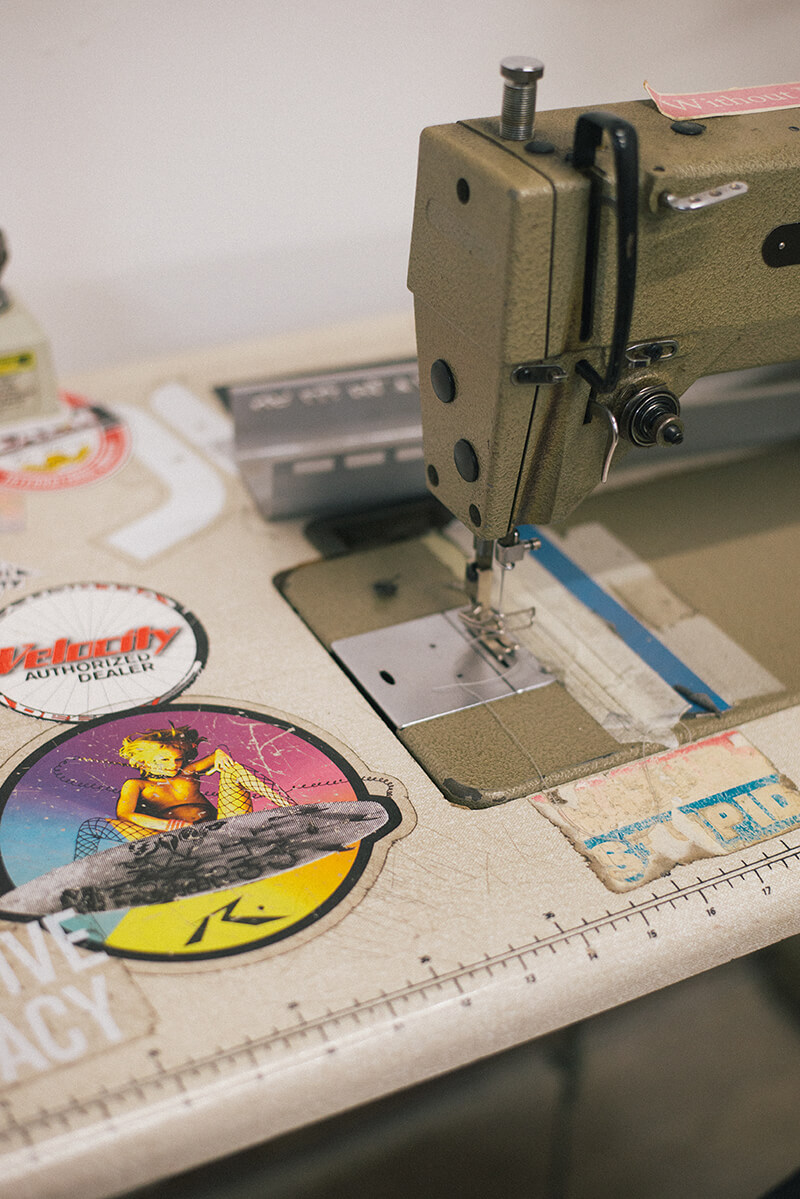
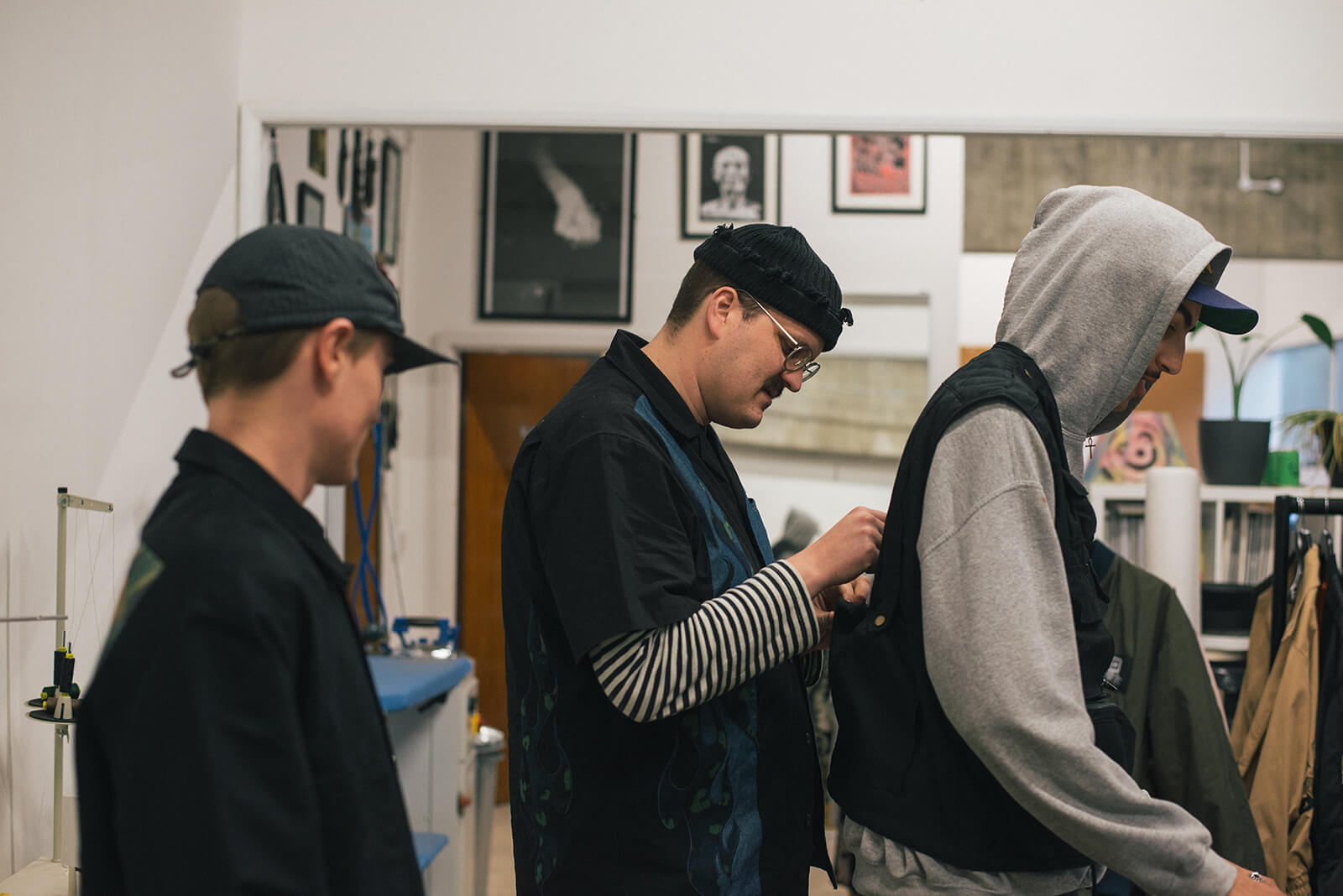
Hodges keeps his finger on the pulse of culture and one eye locked curiously on the future, but for his new project
with ellesse he also had a direct link to the past, accessing and looking for inspiration in the brand’s archive in North
London. Hodges has mentioned in the past that he’d been keen to work with an iconic label’s archive and this was one factor
that drew him to the project. “I’d never seen a brand’s archive before, the way the clothes were designed, drawn, presented,
and even sold was very interesting,” he explains. The archive was stocked floor to ceiling with all manner of apparel spanning
decades, each a chapter in ellesse’s history book. But, surprisingly (or not considering his typically unconventional approach),
Hodges was most attracted to old sales books and technical drawings that spoke, in particular, to ellesse’s history of bringing
together sportswear with traditional elements of tailoring.
One classic campaign that caught Hodges’ attention was for a ski
collection — the sport that ellesse was built on. Hodges knew ellesse’s ski campaigns well, explaining that fashion students
bring them up every time he teaches a sportswear course at the University of Westminster (his old stomping ground), but
discovering and tracing their origins shone a new light on everything he’d seen before.
ellesse was born in 1959 when founder Leonardo Servadio decided to bring his tailoring background to sportswear,
changing the category forever into one that could be fashionable as well as highly functional. For some years, ellesse
focused predominantly on ski gear and Servadio’s understanding of tailoring informed iconic designs like the Jet Pant —
a ski pant with padded knees and a wide lower leg that fit over a ski boot — and quilted jackets. Not long after and
building on the success of its ski apparel, ellesse began making clothing for tennis and with this, the brand’s two
founding pillars were put firmly in place. Servadio proved that tailoring techniques could be of benefit to a performance
piece’s purpose but in improving the overall design aesthetic, also discovered that sportswear could have fashion appeal.
The Jet Pant was such a breakthrough that in 1979 it featured at an event at the Pompidou Centre in Paris celebrating
Italian design. Given its history and the rising popularity of modern interpretations of tailoring today, it’s no wonder
that Hodges wanted ellesse’s old ski gear to form the framework of their collaboration.
“We didn’t want to do a heritage
collaboration. Because that’s crap, we’ve seen that a million times” Hodges explains. “For this one, it felt more about
it being of the moment. Something that felt relevant to them and to us, representative of both brands, rather than too
much one way or the other.” In his eyes, there’s no point in working with another label just to make the same clothes
that he puts on the catwalk but, equally, he saw it as his responsibility to persuade ellesse to travel in directions
they might usually avoid. Hodges got permission to play with their logo and branding, for example; he was adamant on
using certain materials and fabrics that he knew would elevate the collection, like rubber on the sneakers. “Chopping
a brand’s logo up is something that brands normally wouldn’t let you do. They really supported me and my ideas, and they
let me get on with it,” he says.”
Something Hodges knew ellesse would support based on their history with tailoring was the introduction of new fits and cuts.
It was ellesse after all that first introduced many of the design innovations to sportswear during the ‘60s and ‘70s
that we’re familiar with today. Hodges reiterates that this was never going to be a heritage collection and he wasn’t
going to pull and copy stuff directly, but simply playing with fits and cuts in his own way is a subtle nod to the archive
considering what we know about ellesse’s past. He examined old samples and pictures thoroughly but he put the physical
references aside when he started drawing, “it’s always a new thing then, right? Because it’s my memory of it rather than
this carbon copy.”
Hodges’ approach was to spin his favorite elements from the ellesse archive and leave his aesthetic or conceptual mark on
them. “The ski pants and the ski jacket were really important for us because that’s where ellesse’s heritage lies. For us
to update them in our way, mixing the fabrics and adding the print that goes across most of the collection, was really fun,”
e explains. “We really went into the details, so on the tracksuits, we’ve got special zip pulls and stuff, then we’ve added
these wavy lines and played with the colors. Another thing I loved from the ellesse archive was their use of double branding,
so on some pieces, we’ve got the ellesse name on one side and the ‘semi palla’ logo on the other.” The print Hodges mentions
is the ice and salt crystal graphic that’s another abstract reference to ellesse’s ski heritage.
“With these [sneakers], we wanted it to feel like a moon boot, we wanted it to feel industrial, we wanted it to feel like the future.”
– Liam Hodges
It wouldn’t be a Highsnobiety interview without mentioning the collection’s sneaker which clearly take cues from classic ski boots. Yet, again, Hodges never fails to surprise when it comes to artistic influencers and, in this case, he says that he looked to Jacob Epstein’s Rock Drill sculpture for inspiration — the iconic art piece dates back to 1913 but looks like a Star Wars battle droid. “With these, we wanted it to feel like a moon boot, we wanted it to feel industrial, we wanted it to feel like the future.”
Considering Hodges’ reading list and his brand’s forward-thinking philosophy, it’s unsurprising that he wanted to incorporate
visions of the future into the collaboration. Besides, ellesse themselves have brought a progressive approach to design since
Servadio founded the label in the ‘50s. In order to incorporate both a vision of the future and the ellesse archive though,
Hodges approached the collection with a retrofuturist mindset. “It’s a view of the future from the nineties!” he explained.
“I’ve got this picture of my dad from when I was super young and he’s got these silver running shorts on, so we were adamant
that there had to be silver, there was something about silver sportswear that just felt like the future back then.”
In the end, Hodges describes the collection in simple terms, “It feels very ellesse but it’s definitely got our handwriting
all over it.” In part, it’s this nonchalance and refusal to complicate things that make him and his team such a formidable
force. It’s also why the ellesse collaboration works so well — both brands give one another the space and respect they
deserve. Liam Hodges is a brand with clear intent: it’s aspirational, forward-looking, and positive. Likewise, ellesse has
never veered too far from its founder’s original mission to create stylish sportswear with the help of specialist tailoring
techniques. These are the type of credible values that people crave from brands today and unsurprisingly the collection has
been met with praise. As a result, the pair are already working on a Spring/Summer 2020 collection — Hodges wouldn’t show or
ell me anything about it other than that it’s informed by the other half of ellesse’s bedrock: tennis.
Until then though, if
there’s one important lesson we can all learn from Liam Hodges and his team it’s that you can run a successful luxury fashion
label and still piss off to the pub in the middle of the day with your mates.
The ellesse x Liam Hodges collaboration is due to launch later this year and will be available via ellesse.com.
ellesse Then & Now Gallery
-
Photography:
Julien Tell -
Production:
Rochelle Bambury -
Set Designer:
Eva Jauss -
Gaffers:
Lighthawk
Meeting of Styles Interview
-
Director:
Dumas Haddad -
DOP:
Courtney Bennett -
Producer HS:
Rochelle Bambury -
Art Director:
Stella Richter - Special thanks to Not Just Another Store.
Tailoring Lookbook
-
Photographer:
Highsnobiety -
Art Director:
Stella Richter -
Producer:
Rochelle Bambury -
Stylist:
Greta Tettamanzi -
HMU:
Susanna Jonas -
Gaffers:
Lighthawk -
Models:
Sara @Girls ClubManagement and Tom @IMG
Liam Hodges Interview
-
Photo & Video:
Blue Laybourne -
Editor:
Aaron Howes

